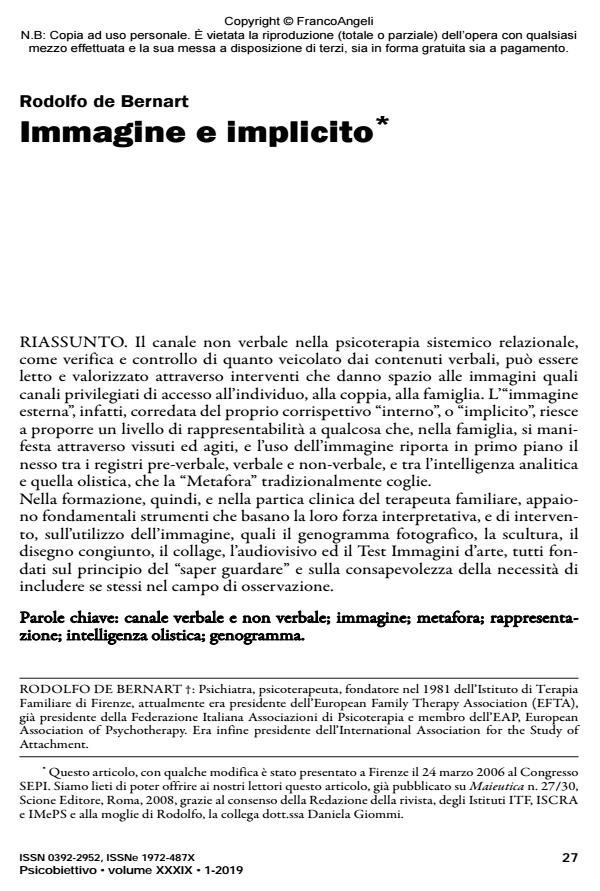Images and implicit
Journal title PSICOBIETTIVO
Author/s Rodolfo De Bernart
Publishing Year 2019 Issue 2019/1
Language Italian Pages 14 P. 27-40 File size 130 KB
DOI 10.3280/PSOB2019-001004
DOI is like a bar code for intellectual property: to have more infomation
click here
Below, you can see the article first page
If you want to buy this article in PDF format, you can do it, following the instructions to buy download credits

FrancoAngeli is member of Publishers International Linking Association, Inc (PILA), a not-for-profit association which run the CrossRef service enabling links to and from online scholarly content.
The non-verbal channel in systemic relational psychotherapy acts as verification and control process of what is conveyed by verbal contents. It can be read and enhanced through interventions that give space to images as privileged channels of access to the individual, the couple and the family. The "external image", in fact, accompanied by its own "internal" or "implicit" consideration, succeeds in proposing a level of representability to something that, in the family, manifests itself through experiences and acts. The use of the image brings in the foreground the connection between the pre-verbal, verbal and non-verbal registers, and between analytical and holistic intelligence, which the "Metaphor" traditionally grasps. During training and the clinical formation of the family therapist there are fundamental tools that base their interpretative force and intervention on the use of the image such as the photographic genogram, sculpture, joint drawing, collage, the audiovisual and the test images of art. All these are based on the principle of "knowing how to look" and on the awareness of the need to include oneself in the field of observation.
Keywords: Verbal and Non-Verbal Channel; Image; Metaphor; Representation; Holistic Intelligence; Genogram.
- Trame di luce Uso di immagini d'arte in terapia individuale e di coppia ad orientamento sistemico-relazionale Conny Leporatti, in PSICOBIETTIVO 1/2016 pp.137
DOI: 10.3280/PSOB2016-001010 - La luna e i falò. Uso di immagini d'arte in psicoterapia individuale e di coppia ad orientamento sistemico-relazionale Conny Leporatti, in TERAPIA FAMILIARE 111/2016 pp.51
DOI: 10.3280/TF2016-111004 - La supervisione aperta. Un modello evidence-based di supervisione Sabrina Tosi, in PSICOBIETTIVO 3/2024 pp.85
DOI: 10.3280/PSOB2023-003006
Rodolfo De Bernart, Immagine e implicito in "PSICOBIETTIVO" 1/2019, pp 27-40, DOI: 10.3280/PSOB2019-001004